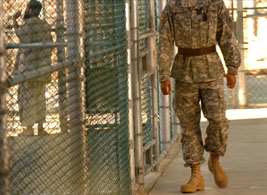 Thanks to the notoriety of certain wartime prisons, the English language doesn’t lack for terms to describe the jails that house prisoners of war and others. In World War II the Japanese had no common name for their camps, at least none that has come into English, but the Germans did. Theirs was stalag, an acronym from the German Stammlager, which imprisoned mainly enemy privates and noncommissioned officers. Stalagluft was a comparable facility for air force personnel, run by the German Luftwaffe, or air force, and Offizierlager, or oflag, for enemy officers.
Thanks to the notoriety of certain wartime prisons, the English language doesn’t lack for terms to describe the jails that house prisoners of war and others. In World War II the Japanese had no common name for their camps, at least none that has come into English, but the Germans did. Theirs was stalag, an acronym from the German Stammlager, which imprisoned mainly enemy privates and noncommissioned officers. Stalagluft was a comparable facility for air force personnel, run by the German Luftwaffe, or air force, and Offizierlager, or oflag, for enemy officers.
When is a prison called a ‘camp’? In wartime, of course
A number of popular plays and films about the dramatic escapes of prisoners brought the noun stalag into English. One of them, Stalag 17 (1953), has been called the quintessential prisoner-of-war film. William Holden won an Oscar for his performance as a cynical POW suspected of leaking secrets to his German captors. Another, Stalag Luft (1994), a satirical take on a plot by British airmen to escape, did not win great acclaim.
The internment of civilians, either in wartime or for political reasons, also gave rise to various names. The Russian gulag, the name of a forced labor camp for political enemies of the Soviet Union, was similarly formed from the Russian acronym for the Main Directorate of Corrective Labor Camps. Like stalag, gulag has been extended to mean any prison or detention camp, and its provenance in English was enhanced by the writings of Aleksandr Solzhenitsyn, who spent eight years in a gulag for criticizing Stalin.
Today many of us associate the phrase concentration camp with the Nazi imprisonment of Jews, Gypsies, homosexuals, Freemasons, and other “undesirables,” millions of whom were killed in camps during World War II. However, the name, if not the practice, originated with Lord Horatio Kitchener’s detention of noncombatants during the Boer War. Responding to guerrilla resistance to his troops, Kitchener rounded up not just Boer soldiers but also their wives and children and threw them into hastily improvised camps with terrible living conditions.
Indeed, the English name came from a practice introduced by Gen. Valeriano Weyler y Nicolau in Cuba in 1896–1897. Sent there to quell a revolt against Spanish rule, Weyler decided to bring civilians to central locations to keep rebels from hiding in their midst. The policy was called reconcentration, and the inmates, known as reconcentrados, endured terrible conditions and were not allowed to work their fields. More than 300,000 reportedly starved, sparking outrage in the United States that helped precipitate the Spanish-American War in 1898.
An opprobrious term arising soon after the Japanese attack on Pearl Harbor was enemy alien. It was initially applied to our country’s Japanese residents, especially along the West Coast, some of whom were thought to be spies. Hostility toward Japan forced the Roosevelt government to confine thousands of Japanese-Americans in special prisons, or internment camps. These were more humane than Nazi prisons but still deprived inmates of their freedom. Only recently has the U.S. government apologized and expressed regret for this. Although there was similar American hostility against Germans during World War I and II, no such measures were taken against them.
At the end of World War II, thousands of Europeans had in effect lost their homelands. They were known as displaced persons, or DPs, and the Allied forces set up displaced-person camps for them. Many were Jews rescued from Nazi camps; others were Eastern Europeans trying to escape the Soviets. The majority of the camps were located in Germany and Austria, and many were managed by the United Nations Relief and Rehabilitation Administration during the Allied occupation (1945–1951). Despite attempts at repatriation, by 1953 there were still more than 250,000 refugees. Germany and Austria eventually accepted most of them, and the last DP camp closed in 1957.
Recent conflicts also have given rise to camps of one form or another, notably the U.S. prison at Guantánamo Bay, Cuba. Called a detention camp, it has held 775 detainees since the beginning of the Afghan war in October 2001. Many of these have been released without charge or transferred elsewhere. President Barack Obama has pledged to close Guantánamo, nicknamed Gitmo: At this writing fewer than 200 prisoners remain, of which 60 to 80 are to be tried.





